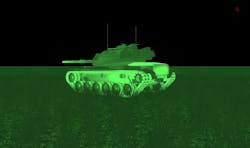Army surveys industry for companies to build rapidly deployable thermal emitters for target identification
NATICK, Mass. – U.S. Army researchers are surveying industry to find companies able to provide electro-optical thermal emitters to represent commercial and military assets for target identification training.
Officials of the Army Combat Capabilities Development Command Soldier Center in Natick, Mass., issued a request for information (W911QY-21-R-TSTR) on Tuesday for the Thermal Signature for Targeting Representation project.
Army researchers want thermal emitters that are rapidly deployable, self-sustaining, and efficient. This announcement also seeks to help the Army evaluate the state of the technology readiness and state of the market.
Army experts primarily are interested in emitters that currently are under evaluation in commercial settings, other government agencies, or related applications.
The emitters should have a modular design configurable to different shapes and forms, and exhibit zone-controlling features that could be programmable to different shapes, forms, and signature profiles.
Thermal emitters should comprise several modular components no larger than six inches on any geometric dimension, be able to mimic a surface area of at least three feet wide and two feet long, and weigh no more than 50 pounds when assembled.The Army wants emitters should have the capability of remote control and activation from as far away as 100 meters. Timed activation and deactivation also will be considered.
The device should aim to mimic thermal signatures as hot as 250 degrees Fahrenheit while operating between the mid-to high- infrared range. It also should have an operation time between six to eight continuous hours, and operate in temperatures from -20 to 120 F.
Related: Day-and-night sensor for target recognition and artillery aiming introduced by Senso Optics
Unpowered, battery-powered and wired power solutions will be considered where appropriate, and setup and deployment should take less than 15 minutes, with no specialty tools. Devices should be reusable for at least 25 times, explore stationary and mobile options, and offer two-man transport and deployment.
Companies should email 5-page white papers in .pdf form no later than 9 March 2021 to the Army's Luis Padilla at [email protected].
More information is online at https://beta.sam.gov/opp/e154e56e358e4087bab75af91ec5b44e/view.
About the Author
John Keller
Editor-in-Chief
John Keller is the Editor-in-Chief, Military & Aerospace Electronics Magazine--provides extensive coverage and analysis of enabling electronics and optoelectronic technologies in military, space and commercial aviation applications. John has been a member of the Military & Aerospace Electronics staff since 1989 and chief editor since 1995.
